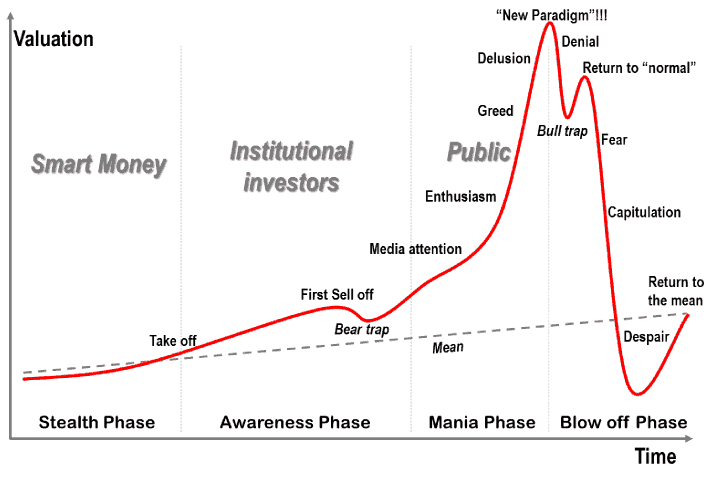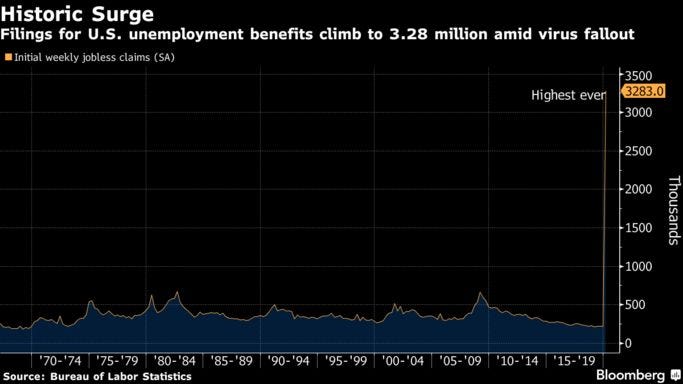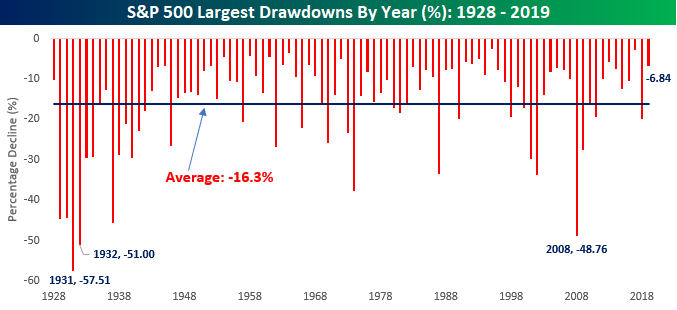The following was first published on Medium.com
I hate to be the bearer of bad news, but the stock market crash has only just begun. This is anything but fearmongering. It’s a fact. The market is telling us that stocks are in sell-off mode and that the V-shaped recovery everyone is both expecting and forecasting will be put on hold.
In every downturn, there’s a classic bear market rally, a bull trap: the period where investors who think asset prices will rise indefinitely continue to believe this new paradigm. This week’s bounce in stocks is masquerading as a return to normal, but, in reality, it’s the beginning of the bear market. This time, it’s not a correction. The bubble has burst. Pure and simple.

If we look at the stages of a bubble, the real crash begins after a relief rally. Why is that? As we’ve seen only a drawdown of 20% so far, everyone is still bullish. In this scenario, the majority of investors expect the opposite of what the market is telling them. Everyone with a conflict of interest who appears on financial media tells you to buy stocks: how there are great bargains out there, how the recent sell-off is the biggest opportunity in our lifetime, and how we will miss out if we fail to buy now. Of course, over history, these types of comments serve as a big red flag for anyone who understands how extreme bullishness in a bear market leads to more losses.
From a macro point of view, it’s obvious that the stock market will fall further if the entire economy shuts down for a month or two or more. This is not recession level stuff, it’s depression level stuff. Every company and every startup that’s levered to the max will go bust as there’s no way for them to service their debts when money is tight — even with aggressive help from the Fed and their new range of alphabet soup-sounding purchase programs: PDFC, ESF, MMLF, TALF, CPFF, SMCFF, PMCFF, or in other words: the Fed is buying up the entire economy. This is bad for stocks because a lot of these companies make up the major stock market indices: the S&P500, the Nasdaq, and the Dow Jones. What could possibly go wrong?
If you still need convincing, forward-looking market data is the smoking gun.
Depression Level Jobless Claims
The latest jobless claims print was the worst ever by a country mile.

Worst Global Business Confidence (PMIs) On Record
Global PMIs are at their lowest levels ever. Again by a country mile.
50% Drawdowns During Both Recessions and Depressions
If we’re going into a recession or even a depression, the bear market drawdown has only just begun. With the average crash percentage being around 50%, and with the recent crash being around 20%, we’re less than halfway to a realistic stock market bottom.

Extreme Volatility Makes a Market Uninvestable
Volatility has reached levels not seen since the Great Recession, and that’s before seeing the full extent of the damage from defaults in the coming months — which may result in the real financial crisis.
With the VIX ranging from 60–80, this market is simply uninvestable. The only people trading in this market environment are people who must do so to save themselves; not for profit, not for gains, but for closure. They need to get out and will do so at any price.
When Will The Stock Market Bottom?
Shutting down the economy for only a few months has catastrophic implications for our phony, debt-based economy, so the idea that we will simply return to normal is absurd. The economy needs time to heal and rebuild, which will take months if not years.
Markets will start to bottom as the recovery begins. As society finishes purging all the malinvestments investors made over the last economic cycle, the money left over will be put to work, this time — hopefully — into sounder investments.
For now, though, instead of “buying the dip,” listen to what the market is telling you, not what the talking heads are telling you. Resist the urge to pick a bottom in the stock market and be patient. Wait for economic data to turn positive, wait for volatility to return to investable levels, and wait for a Coronavirus resolution.
Submission will prove to be the best asset any investor buys and holds during the COVID-19 outbreak because, in a crisis, the best trade is to avoid catching a falling knife.
The views represented in this commentary are those of its author and do not reflect the opinion of Traders Magazine, Markets Media Group or its staff. Traders Magazine welcomes reader feedback on this column and on all issues relevant to the institutional trading community.




